
Browse an alphabetical list of photographs. These historical images portray people, places, and events before, during, and after World War II and the Holocaust.
<< Previous | Displaying results 1701-1750 of 2641 for "Photo" | Next >>
Otto Ohlendorf, commander of Einsatzgruppe D (mobile killing unit D), during Trial 9 of the Subsequent Nuremberg Proceedings. This photograph shows Ohlendorf pleading "not guilty" during his arraignment at the Einsatzgruppen Trial. Nuremberg, Germany, September 15, 1947.
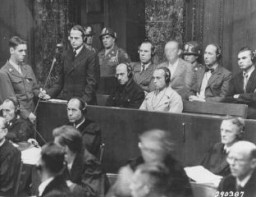
Ottoman military forces march Armenian men from Kharput to an execution site outside the city. Kharput, Ottoman Empire, March 1915-June 1915. [Courtesy of the Armenian National Institute.]
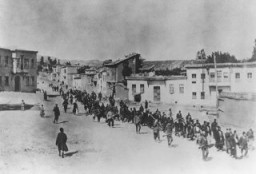
A German couple reads an outdoor display of the antisemitic newspaper Der Stürmer (The Attacker). Germany, 1935.
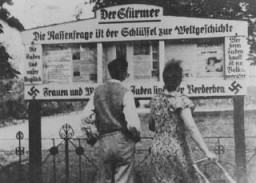
Scene of prewar economic life: Jewish vendors sell their wares at an outdoor market in front of the Stara synagogue. Krakow, Poland, 1936.
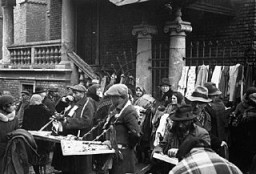
Liberated prisoners demonstrate the overcrowded conditions at the Buchenwald concentration camp. Photograph taken after the liberation of the camp. Buchenwald, Germany, April 23, 1945.
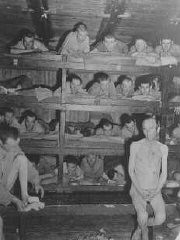
Page from the antisemitic German children's book Trau Keinem Fuchs... (Trust No Fox in the Green Meadow and No Jew on his Oath). The illustration uses antisemitic caricatures in an attempt to promote Nazi racial ideology. Germany, 1936.
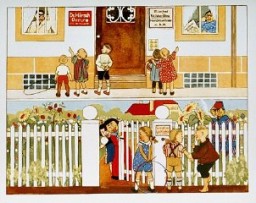
Page from the antisemitic German children's book, "Trau Keinem Fuchs..." (Trust No Fox in the Green Meadow and No Jew on his Oath). Germany, 1936.
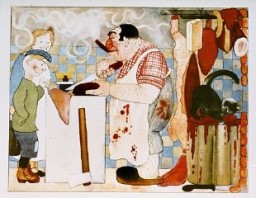
A page from Anne Frank's photo album showing snapshots taken between 1935 and 1942. Amsterdam, the Netherlands.
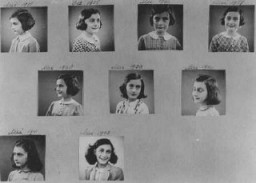
Page from the antisemitic German children's book, "Trau Keinem Fuchs..." (Trust No Fox in the Green Meadow and No Jew on his Oath). Germany, 1936.
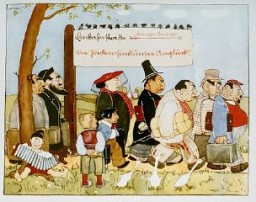
Page from a diary written by Elizabeth Kaufmann while living with the family of Pastor André Trocmé in Le Chambon-sur-Lignon. Le Chambon-sur-Lignon, France, 1940–41.
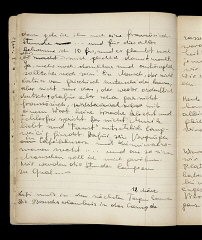
Page from Karl Höcker's album, with the caption "Yuletime, 1944." The photographs show Karl Höcker lighting the candles on the Yule tree. 1944.
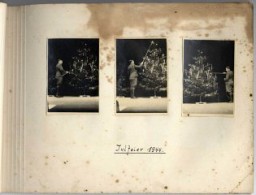
Otto Wolf (1927-1945) was a Czech Jewish teenager who chronicled his family's experience living in hiding in rural Moravia during World War II. His diary was published posthumously. This image shows book 4 of Otto Wolf's diary. This is the first entry by Felicitas Garda (Otto Wolf's sister) dated April 17, 1945. Felicitas continued Otto's diary after his disappearance.
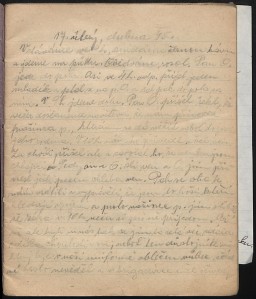
A page from the diary of Eugenia Hochberg, written while she was living in hiding in Brody, Poland. The page contains a timeline of important events that happened during the war, such as deaths and deportations of family and friends. Brody, Poland, July 1943–March 1944.
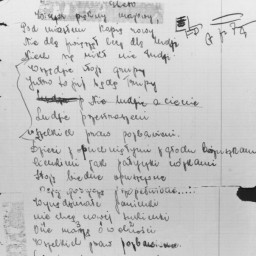
Page from the diary of Peter Feigl, a Jewish child hidden in the Protestant village of Le Chambon-sur-Lignon. The photos show his parents, who perished in a concentration camp. The text is in French and German. Le Chambon-sur-Lignon, France, 1942-1943.
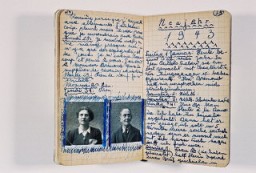
Page from Der Giftpilz (The Poisonous Mushroom). This photograph shows a page from one of several antisemitic children's books published by Julius Streicher's Der Stürmer-Verlag, used for indoctrinating youth. The text reads, "The Jewish nose is crooked at its tip. It looks like the number 6."
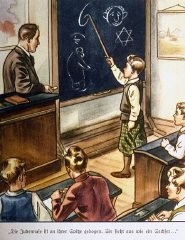
A page from SS officer Juergen Stroop's report on the Warsaw ghetto uprising. He wrote: "This is what the former Jewish residential quarter looks like after its destruction." Warsaw, Poland, April-May, 1943.
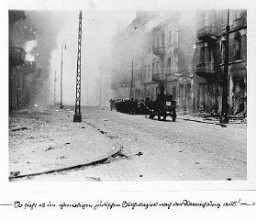
Illustrated page of a child's diary written in a Swiss refugee camp. The diary entry describes how they crossed the border into Switzerland. The text reads, "We came out of the woods and into a clearing: we had to be as quiet as possible because we were so close to the border. Oh! I almost forgot! Before we came out of the woods, they made us stand still for a quarter of an hour while they went to explore the area and to cut through the fence. Fortunately, shortly thereafter, we began to walk again. We saw…
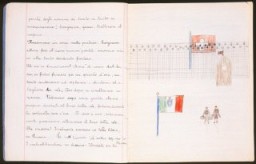
World War I (1914–18) saw the first use of poison gas as a weapon of war. In this oil painting, John Singer Sargent depicted the aftermath of a mustard gas attack on British soldiers during a battle in August 1918. A line of soldiers, with bandaged eyes injured by the gas, hold on to one another as they are led to medical treatment. Around them are rows of other soldiers injured by the effects of the mustard gas, which could cause injuries such as burns and temporary blindness. © IWM (Art.IWM ART…

1943 painting of the Vltava River in Prague created from a photograph by Bedrich Fritta when he was imprisoned in Theresienstadt. Fritta (1909-1945) was a Czech Jewish artist who created drawings and paintings depicting conditions in the Theresienstadt camp-ghetto. Fritta was deported to Auschwitz in October 1944. He died there a week after his arrival.
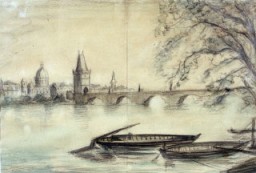
Panzer tanks of Erwin Rommel's Africa Corps during an advance against British armed forces. Libya, 1941-1942.
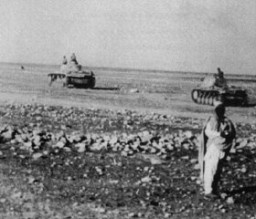
Haviva Reik and other parachutists from Palestine, under British command, sent to Slovakia to aid Jews during the Slovak national uprising. Hayim Hermesh (left), Haviva Reik (second from left), Rafi Reiss (behind Reik), Abba Berdichev (second from the right), and Zvi Ben-Yaakov (right), on the Tri Duby airfield before being sent to Slovakia. Czechoslovakia, September 1944.
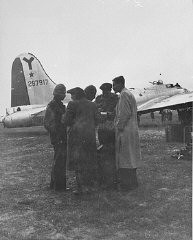
A woman who is concealing her face sits on a park bench marked "Only for Jews." Austria, ca. March 1938.
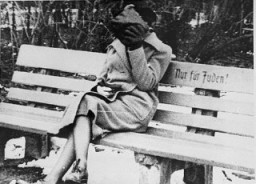
A view of the Buchenwald concentration camp after the liberation of the camp. Buchenwald, Germany, after April 11, 1945.
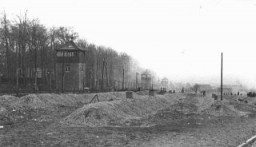
At Der ewige Jude (The Eternal Jew), a Nazi anti-Jewish propaganda exhibition, a case features "typical Jewish external features." Munich, Germany, November 1937.
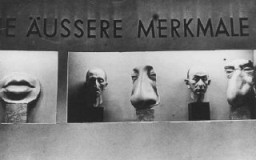
A view of part of the Maginot Line, a French defensive wall built after World War I. It was intended to deter a German invasion. France, ca. June 1940.
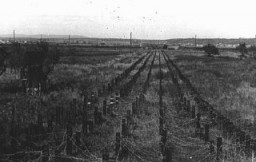
Group portrait of 12 of the participants in the October 14, 1943, uprising at the Sobibor killing center, during which prisoners killed 11 SS staff.
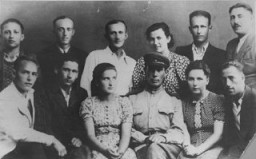
General Michael (Rola) Zymierski (top row, center), commander of the Polish communist Armia Ludowa, poses with a partisan unit in the Parczew Forest. The partisan unit includes the Jewish physician, Michael Temchin (bottom right).
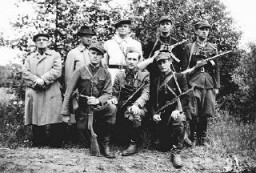
Abba Kovner (center) poses with Ruska Korczak (left) and Vitka Kempner (right) on a street in Vilna the day of the city's liberation.
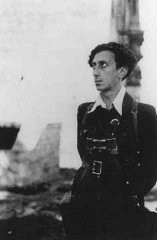
Yugoslav partisans with Jewish parachutists from Palestine. Yugoslavia, 1944.
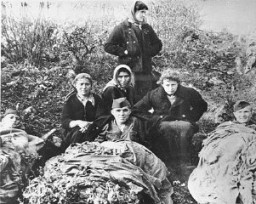
Partisans in the Naliboki forest, near Novogrudok. They were from various fighting units including the Bielski group and escapees from the Mir Ghetto on guard duty at an airstrip in the Naliboki Forest. Poland, July 1944.
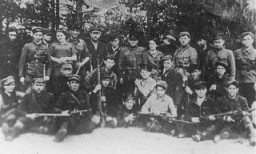
Passengers aboard the St. Louis. These refugees from Nazi Germany were forced to return to Europe after both Cuba and the United States denied them refuge. May or June 1939.
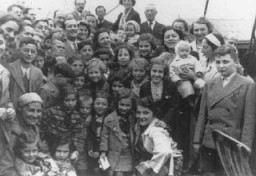
Passengers on board the Exodus 1947 refugee ship, which has just arrived at the Haifa port, peer out of cabin windows. The British forcibly returned the refugees to Europe. Haifa, Palestine, July 19, 1947.

Passengers on the deck of the refugee ship Exodus 1947 in Haifa. British forces returned them to displaced persons camps in Germany, dramatizing the plight of Holocaust survivors attempting to enter Palestine. Haifa, Palestine, July 18, 1947.
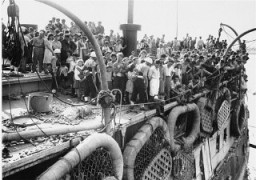
Passengers on the SS Quanza while temporarily docked in Norfolk, Virginia. The Quanza was a Portuguese ship chartered by 317 Jewish refugees attempting to escape Nazi-dominated Europe in August 1940. Photo dated September 10, 1940.
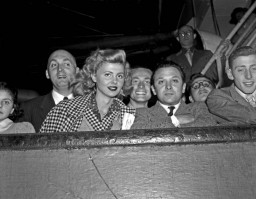
A large family group celebrates the Passover seder. Lodz, Poland, ca. 1938-1939.
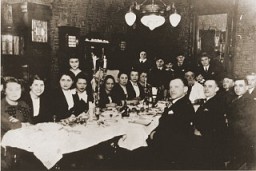
Passport issued to Gertrud Gerda Levy, who left Germany in August 1939 on a Children's Transport (Kindertransport) to Great Britain. Berlin, Germany, August 23, 1939.
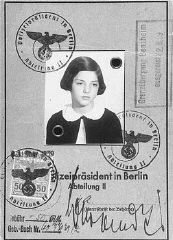
Passport photograph of Raoul Wallenberg. Sweden, June 1944.

Passport issued to Lore Oppenheimer, a German Jew, with "J" for "Jude" stamped on the card. "Sara" was added to the names of all German Jewish women. Hildesheim, Germany, July 3, 1939.
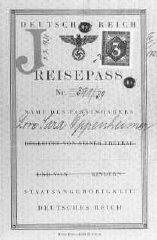
Passports issued to a German Jewish couple, with "J" for Jude (the German word for Jew) stamped on the cards. Karlsruhe, Germany, December 29, 1938.
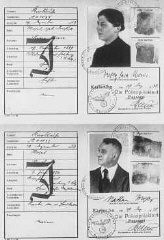
Pastor Martin Niemöller at his desk in his home. Berlin, Germany, ca. 1936.
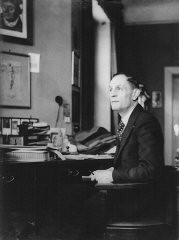
Pastor Martin Niemöller speaks to reporters after his release from a concentration camp. Germany, 1945.
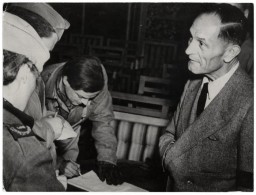
Field Marshal Paul von Hindenburg walks along a flower-covered path on his 70th birthday. On either side, crowds of children cheer. October 2, 1917. Hindenburg will later be elected president of Germany in 1925, during the Weimar Republic. © IWM Q 23976
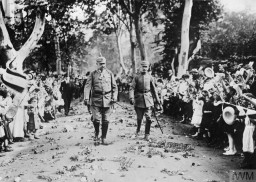
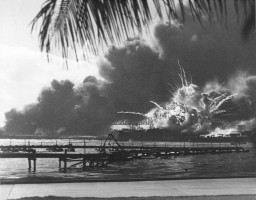
Visitors view the exhibition of the Arrow Cross newspaper, Pesti Ujság, at the International Fair in Budapest. The headline reads: "For a Hungary without Jews." Budapest, Hungary, approximately 1941-1942. The Arrow Cross was Hungary's largest fascist political movement after 1935. In the 1939 parliamentary elections it won over 20% of the vote and had more than 250,000 members. Its ideology was ultra-nationalistic and fiercely antisemitic. The Arrow Cross viewed Jews as an "anti-national" "race"…
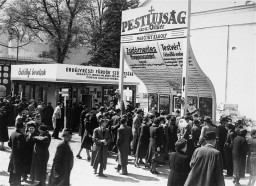
Personnel of T4, the agency created to administer the Nazi Euthanasia Program. Pictured from left to right are: Erich Bauer (chauffeur), Dr. Rudolf Lonauer, Dr. Victor Ratka, Dr. Friedrich Mennecke, Dr. Paul Nitsche,and Dr. Gerhard Wischer. Berlin, Germany, 1939–45.
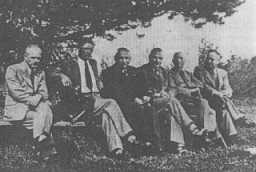
Photo of Peter Feigl, a Jewish child hidden in the Protestant village Le Chambon-sur-Lignon. Le Chambon, France, August 9, 1943.
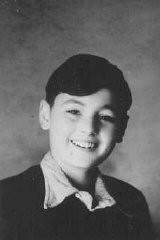
Adolf Hitler tasked Philipp Bouhler, the director of his private office, and Karl Brandt with co-leading the “euthanasia” program.
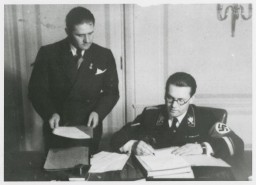
Photo taken a few weeks before World War II began. Regina is at the right of the front row. Kunow, Poland, July 28, 1939.

Clandestine photograph of a Polish political prisoner and medical experiment victim in the Ravensbrück concentration camp. Prisoners in the Ravensbrück concentration camp took several clandestine photographs as evidence of the medical experiments conducted on them. The camp was the site of bone-grafting experiments and experiments to test newly developed sulfa drugs.Pictured here, Bogumila Jasuik was chosen as one of the 74 "rabbits" for medical experimentation. German doctors experimented…
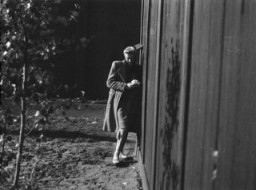
This photograph, part of the Auschwitz Album, was used as evidence in the Frankfurt trial. On the far right, you see Stefan Baretzki, a defendant in the trial, who was convicted partially because this photograph proves that he staffed the ramp.
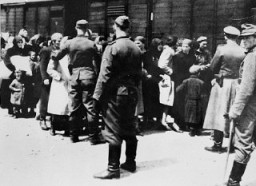
We would like to thank Crown Family Philanthropies, Abe and Ida Cooper Foundation, the Claims Conference, EVZ, and BMF for supporting the ongoing work to create content and resources for the Holocaust Encyclopedia. View the list of donor acknowledgement.